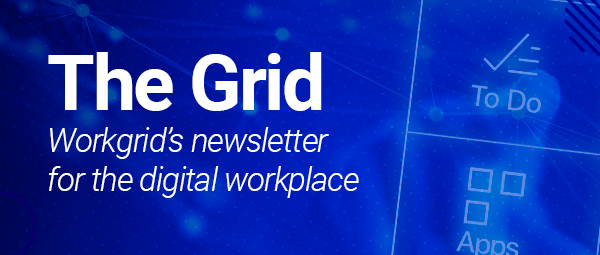The state of digital workplace transformation
We’ve all had that dream where we’re running towards something we really need to get to, yet no matter how fast we move our legs or how badly we want it, our goal never seems to get any closer. That’s sort of the position we’re in with the state of digital workplace transformation right now – everyone is working towards a digital environment that seamlessly supports the future of work, but the reality is, that vision is still a distant spot on the horizon for most organizations.
Let’s look at the facts -
The number of organizations that consider the digital workplace to be an important priority has been more or less stagnant since 2017, and only 14% of businesses consider themselves to be at a “mature” phase of digital workplace implementation.
![[asset] digital workplace maturity report](https://images.ctfassets.net/z7p73u8c0thn/1CZwfYxYWPdVyFO4vqB7BL/b235cdf140b2782748bcc7d2e2284dbf/SMGDigitalMaturityGraph.png?w=819&h=639&q=60&fm=png&bg=transparent)
On the flip side, there’s universal agreement that an effective digital workplace is a critical component in transforming the employee experience. In fact, the number of organizations with an established digital workplace strategy has grown steadily in recent years, up 19% since 2017.
![[asset] digital workplace survey](https://images.ctfassets.net/z7p73u8c0thn/5K65rob04cP1rWqst969ko/d6ac04f27e2578a21c961c3814035a0d/SMGDigitalWorkplaceStrategyGraph.png?w=929&h=543&q=60&fm=png&bg=transparent)
So what's holding organizations back?
There are a number of factors at play, not the least of which include budget constraints, competing initiatives and lack of strategic direction. But the biggest hurdle, however, is the sheer difficulty of reining in all the technological complexity that’s currently at play in most organizations.
Think about the functional groups within your organization. As each of them rolls out specific solutions designed to manage a unique aspect of the business, workers’ ability to focus on their high-value work decreases. Why? Because not only do employees now have to bear the burden of learning an influx of new technology, they also lose valuable time switching between systems as they go about their day-to-day work. It’s an issue that compounds in severity with each new system that’s added.
Consider this:
Context switching, the phenomenon that happens every time an employee toggles back and forth between systems to complete a task, can cost workers up to 80% of the time they have to focus on high value work. Add up all the times each employee has to shift gears over the course of an average work day – completing approvals, submitting expense reports, requesting time off, etc. – and the result can be devastating to business.
A siloed digital workplace is also damaging to the employee experience, which further impacts business success.
Ranked as a top 5 priority by HR professionals, employee experience has rapidly become a main point of differentiation for companies, as well as a keystone to business success:
Companies with highly engaged workers outperform their peers by 147%
Companies that invest in employee experience are four times as profitable as those who don't
But when employees spend a significant portion of their day simply navigating the complexities of the enterprise technology they have to work with, it's unlikely they have the kind of experienced that drives superior business results.
Opportunities abound for organizations to reap the benefits of a more integrated experience of workplace technology.
CMSWire, State of the Digital Workplace Report, 2019
Creating a digital workplace that improves employee experience
So how can organizations create the kind of digital workplace that improves the employee experience and fuels business success? Thankfully, the answer to that is pretty straightforward: by being more focused on employees.
Now organizations might argue that they are in fact focused on employees – isn’t the abundance of technology proof of their desire to help their workers be more efficient?
Well, yes and no.
There’s no question that organizations are well intentioned in their motives for arming employees with a whole arsenal of best-in-class solutions designed to handle a variety of niche tasks. But the result of those efforts is definitely counterproductive in their goal of assisting employees.
Workers waste 32 days a year due to workplace efficiency apps
44% of the time, employees cannot find the information they need
To deliver a truly employee-focused digital workplace, one that increases productivity and mimics the levels of consumer-like simplicity employees are accustomed to, organizations need to reduce the frustration that comes with all the mundane administrative tasks inherent in every job. That starts with understanding employees’ needs.
Far too often, organizations design digital experiences using a top-down approach, buying world-class systems in silos with little consideration for how they’ll play out for employees across the enterprise. HR is a common example of this. Most HR systems are built with power users in mind, so they have a user experience designed for that profile. Yet 90% of those systems will never be leveraged by the general employee population. When you force that power user experience onto employees for the simple yet high-volume transactions they need to do, it creates a difficult and fragmented experience. Not only do users have to jump through hoops to log into a special system (e.g. knowing how to access the system, multi-factor authentication etc.), they also have to have some level of institutional knowledge, such as how to even navigate through the system to the screens that are relevant to their need.
Organizations can avoid creating that kind of negative experience by taking an active role in understanding employees’ day-to-day challenges. That can take the form of shadowing workers, conducting surveys and interviews, constructing journey maps, etc. The more information organizations have on the daily routines of all their employees across the enterprise, the clearer the persistent frustrations become and the easier it is for business to find solutions that make the work day simpler.
How can technology help create a more employee-focused digital workplace?
When it comes to making work simpler for employees, the bottom line is this -- it’s time to use the technologies that are available to us, like AI, to start making enterprise solutions adapt to how humans work, rather than humans having to adapt to enterprise solutions.
Implementing a digital experience layer is the ideal first step in achieving this.
![[asset] experience layers manage complexity](https://images.ctfassets.net/z7p73u8c0thn/7oNHCYYYvB44Le9opbhlqr/5b767c8154b0c3d00517d01e11dd9879/Experience_Layers.jfif?w=1200&h=677&fl=progressive&q=60&fm=jpg&bg=transparent)
Digital experience layers create a streamlined, contextual experience that exists above the technological complexity of an organization. They reduce the cognitive load on employees by orchestrating across all important systems on the employee’s behalf, seamlessly abstracting only the critical information each employee needs to know or act on. It then presents that information in a streamlined experience that mimics the consumer experiences employees have become accustomed to. No more toggling, no more wasted time, and no more frustration.
Even better? You can achieve a digital experience layer - and all the benefits it provides- using the existing technology structure you already have! To find out how to make this happen, check out part two of our series, which includes 9 key elements of a successful employee-centric digital experience platform.




